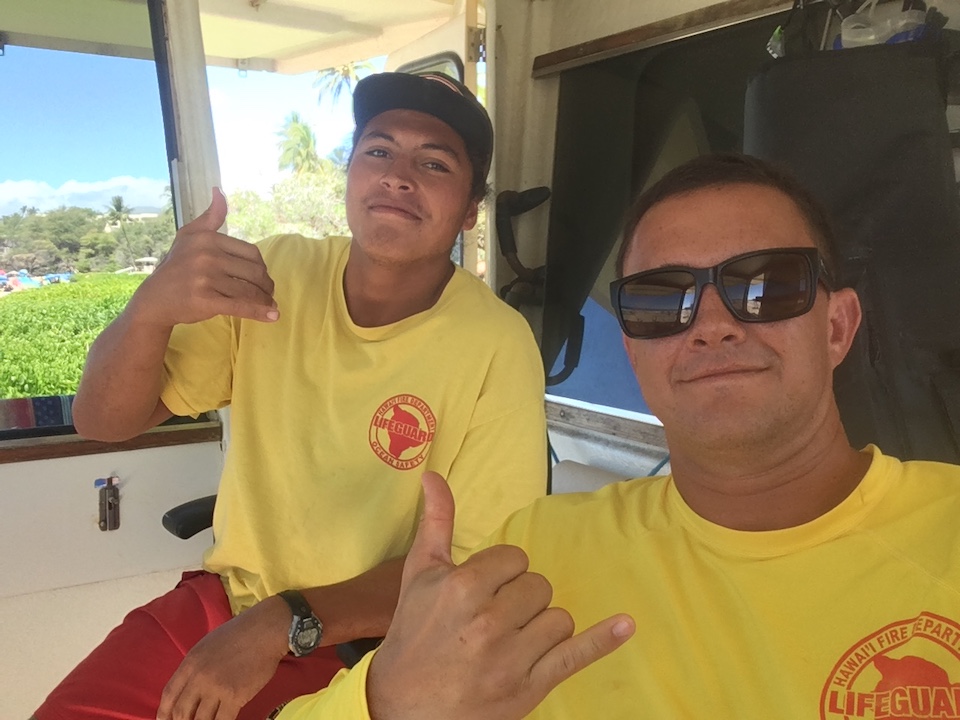Rescue at Kua Bay: ʻThat lady was dead and they saved her lifeʻ
The Saturday morning of Oct. 22 was sunny with blue skies at beautiful Kua Bay in West Hawaiʻi. Waves were 1 to 3 feet with the occasional set of 4-footers. Everyone on the beach and in the water was enjoying themselves, seemingly unaware of the elderly woman floating face down.
Everyone except for Ocean Safety officer Ian McVeigh. He had just showered and returned to the lifeguard tower after running along the beach when he noticed what appeared to be a piece of clothing in the waves.

McVeigh recalled asking fellow ocean safety officer Ula Pilago: “Was that a body?”
“As soon as I seen skin,” the 34-year-old recalled Tuesday, “I ran as fast as I could,” jumping over a pile of bodyboards that were in the way.
“He flew by me,” beachgoer Scott Watson said. “He took eight steps and he was in the water.”
The victim’s family also was in the water. As soon as they noticed something was wrong, they attempted to pull her out.
“I told them to get out of the way,” McVeigh said.
The lifeguard got his arms under her arms, secured her from the back, and started walking backward toward the shore. Pilago, the other lifeguard, grabbed her legs as they carried her up a bank of sand to a more flat dry area.
“He was exhausted just getting her up on the beach,” Watson recalled of McVeigh. “Everyone on the beach thought she was dead.”
After lying the woman down, McVeigh checked for signs of life. When none were found he started chest compressions. Pilago ran back to the tower and returned with a breath valve mask and a defibrillator, also known as an AED.
“I was trying to stay as calm as I could,” McVeigh said. “I told everyone around us to call 911.”
McVeigh said it felt like a few minutes of doing chest compressions while Pilago administered oxygen. A nurse at the beach assisted in setting up the AED. Prior to delivering a shock, the lifeguard said they saw her come back to life as her eyes and lips started moving.
McVeigh said the victim’s first words were: “Ow, my back.”

The lifeguards determined she most likely had a back injury and had her stay still. They brought her daughter to her side to help keep her calm.
“We just kept her calm and kept her alive until the medics got there,” McVeigh said.
Watson put it more bluntly: “I’ve never witnessed something like that and it was awesome. That lady was dead, and they saved her life.”
The victim, who was a tourist, was not identified.
Kua Bay is a popular beach for locals and visitors to the Big Island, but it also is known for its high surf and dangerous shore breaks. The beach is almost 7 miles north of Ellison Onizuka Kona International Airport. The closest fire station is about 15 minutes away in Kailua-Kona.
“It’s dangerous and fairly remote,” said Hawai‘i Fire Assistant Chief Darwin Okinaka, adding that it is imperative to have lifeguards there.
It took years to get a lifeguard tower at Kua Bay, a state park. Funding for the positions needed to be approved by the State Legislature.
The tower has only been up since July 1, 2019. Since January, lifeguards at the beach have performed 43 rescues. In 2021, Okinaka said there were approximately 83 rescues.
There are four full-time employees that work at Kua Bay. Pilago and McVeigh have been stationed at the tower since it opened. On any given day there are three lifeguards scheduled.

Pilago said he’s done rescues at Kua Bay before there was a lifeguard tower and he has seen community members put their safety at risk to help people who got in trouble in the water. Now that ocean safety officers watch over the beach daily, Pilago hopes the community can come and enjoy Kua Bay safely.
Community members also have advocated for a lifeguard tower at Honl’s Beach Park in Kona off Ali‘i Drive. Ocean Safety Capt. Ricky Alvarez said there have been two recent rescues from the beach. Both occurred in 2021 when an off-duty lifeguard surfing at the beach discovered a man floating face down and pulled him to shore.
Alvarez said Hawai‘i Community Policing Officer Rueben Pukahi also rescued someone from the waters at that beach.
At Kua Bay, Watson captured footage of the aftermath of the lifeguards’ rescue as first responders from the Hawai‘i Fire Department took over and transported the woman to a nearby hospital. Watson said people on the beach were in tears following the rescue, saying McVeigh was a pro.

“The lifeguard was totally focused. They were exhausted,” Watson said. “He gave her CPR for 15 straight minutes. He saw some signs, got her revived, and talked to her family.”
After the paramedics left, Pilago and McVeigh went back to work. Watson was impressed with their professionalism and humility.
McVeigh told Watson: “Just doing what we do, you know. Glad to see her okay.”
When McVeigh went back to the tower after the rescue, he said he stood there for a minute and thought: “That was intense.”
“We get a lot of people down here and what we do is super important,” McVeigh said. “I feel like we have the best job in the world.”
Sponsored Content
Comments








